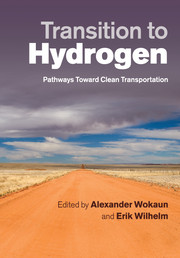Book contents
- Frontmatter
- Contents
- Contributors
- Foreword: on the transition to hydrogen
- Preface
- Executive summary
- Abbreviations
- 1 Introduction
- 2 Life cycle assessment of hydrogen production
- 3 Technical characterisation and multi-criteria analysis of light-duty vehicles
- 4 Hydrogen emissions to the atmosphere from industry and transportation
- 5 Regional fleet simulation
- 6 Long-term scenarios of the global energy and transport system
- 7 Integrated assessment of hydrogen in transportation
- Appendix A Summary of fundamental assumptions
- Appendix B Selected input assumptions, technology descriptions, and heuristics
- Appendix C Characteristics of the present and future vehicle designs
- Appendix D Survey questionnaire and aggregated responses
- Appendix E Assumptions and inputs driving fleet dynamics simulation
- References
- Index
- Plates
4 - Hydrogen emissions to the atmosphere from industry and transportation
Published online by Cambridge University Press: 05 November 2011
- Frontmatter
- Contents
- Contributors
- Foreword: on the transition to hydrogen
- Preface
- Executive summary
- Abbreviations
- 1 Introduction
- 2 Life cycle assessment of hydrogen production
- 3 Technical characterisation and multi-criteria analysis of light-duty vehicles
- 4 Hydrogen emissions to the atmosphere from industry and transportation
- 5 Regional fleet simulation
- 6 Long-term scenarios of the global energy and transport system
- 7 Integrated assessment of hydrogen in transportation
- Appendix A Summary of fundamental assumptions
- Appendix B Selected input assumptions, technology descriptions, and heuristics
- Appendix C Characteristics of the present and future vehicle designs
- Appendix D Survey questionnaire and aggregated responses
- Appendix E Assumptions and inputs driving fleet dynamics simulation
- References
- Index
- Plates
Summary
Introduction
Hydrogen has the potential to become a sustainable energy carrier of the future, particularly for transportation. Until recently, H2 emissions to the atmosphere from anthropogenic sources have been largely disregarded and viewed in large part as a product of incomplete fossil fuel combustion. As H2 production and the fraction of energy-based H2 applications increase, a potential accumulation of H2 in the atmosphere from direct emissions, losses and leakage, and changes in chemical processes in both the troposphere and the stratosphere could result. Vehicle exhaust gas is currently an important source of anthropogenic H2 to the atmosphere, and losses of H2 from production, distribution, storage, and other end-use systems could become increasingly significant contributors. With changing vehicle fleet composition and increasing H2 demand and production for industrial and direct energy-based end-uses, an assessment of well-to-wheel H2 emissions, including H2 emissions from current and emerging vehicle technologies, will help assess the magnitude of future technological anthropogenic H2 emissions to the atmosphere.
Objectives and scope
Apart from the challenging technical questions associated with the production, transport, and storage of H2, future anthropogenic H2 emissions are an area of increased interest due to their prominence in the global H2 budget (see Figure 4.1). Currently, large uncertainty is associated with the contribution of H2 from technological processes, primarily from fossil fuels (white arrow, Figure 4.1). A detailed analysis of H2 emissions from the major anthropogenic processes that contribute to the present and future global H2 budget has been performed in this work and serves to better quantify the contribution from this sector.
- Type
- Chapter
- Information
- Transition to HydrogenPathways Toward Clean Transportation, pp. 96 - 127Publisher: Cambridge University PressPrint publication year: 2011



